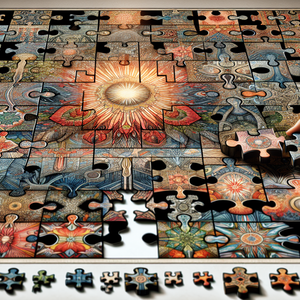The Evolution of Louis Vuitton: From Trunks to Virtual Reality

Louis Vuitton was founded by its namesake in Paris, where it quickly gained a reputation for producing durable and stylish travel trunks. The brand's early success was largely due to its innovative designs, including the introduction of flat-topped trunks that could be easily stacked—an essential feature for travelers in the 19th century. These trunks were not only practical; they were also fashionable, setting the stage for the brand’s future in luxury. The iconic LV monogram, which debuted in 1896, served as a mark of authenticity and became a symbol of luxury and sophistication. This visual branding created an immediate association with quality and exclusivity, helping the brand establish a loyal customer base among Europe’s elite. As the decades progressed, Louis Vuitton expanded its product offerings beyond trunks to include bags, accessories, and ready-to-wear clothing. This shift was pivotal; the brand transformed from a functional travel goods manufacturer to a luxurious fashion house that appealed to a broader audience. The 1980s and 1990s marked a significant turning point, as Louis Vuitton collaborated with contemporary artists and designers, such as Stephen Sprouse and Takashi Murakami. These partnerships infused pop culture into its traditional aesthetic, attracting a younger demographic and redefining the boundaries of luxury.
Embracing Digital Transformation
The 21st century brought about an unprecedented digital revolution, fundamentally changing the way fashion is consumed. Louis Vuitton has adeptly navigated this change, embracing e-commerce and creating a seamless online shopping experience that caters to modern consumers. By establishing a robust online presence, the brand has made its luxurious offerings accessible to a global audience. However, Louis Vuitton’s innovation extends far beyond traditional online retail. The introduction of virtual reality (VR) and augmented reality (AR) technologies in fashion represents one of the most exciting developments in the industry. Louis Vuitton has led the charge in this domain, utilizing VR to enhance customer experiences. For instance, the brand's virtual fashion shows allow audiences worldwide to experience the grandeur and artistry of its collections in real-time, breaking down geographical barriers. A notable example of this digital engagement occurred in 2021, when Louis Vuitton collaborated with the popular video game "League of Legends," creating exclusive in-game skins and merchandise. This innovative partnership highlighted the intersection of digital culture and high fashion, attracting a diverse demographic of gamers and fashion enthusiasts alike.
Sustainability and the Future
As consumer awareness surrounding sustainability grows, Louis Vuitton is also adapting its practices to meet these expectations. The brand's commitment to sustainability is reflected in its initiatives aimed at reducing its environmental impact, such as upcycling materials and investing in sustainable production methods. This evolution towards eco-consciousness is not just a trend; it represents a fundamental shift in how luxury brands must operate in the modern world. Moreover, the integration of technology and sustainability offers a fresh perspective on the future of fashion. Louis Vuitton is exploring blockchain technology to ensure transparency in its supply chain, allowing consumers to verify the authenticity and sustainability of their purchases. This innovative approach not only reinforces the brand's commitment to quality and craftsmanship but also builds trust with an increasingly discerning consumer base. By merging luxury with sustainability, Louis Vuitton is setting a precedent for other luxury brands, demonstrating that high fashion can indeed coexist with ethical practices and environmental responsibility.
The journey of Louis Vuitton from a humble trunk maker to a leader in virtual fashion showcases the brand's ability to adapt and evolve in a rapidly changing landscape. By embracing digital transformation, fostering artistic collaborations, and prioritizing sustainability, Louis Vuitton continues to redefine luxury in the modern age. As the brand navigates the intersections of tradition and innovation, it remains a powerful force in the fashion industry, captivating both long-time aficionados and a new generation of consumers. The evolution of Louis Vuitton is not merely a story of a brand; it is a reflection of the changing world of fashion itself, where history, technology, and culture converge. As Louis Vuitton steps boldly into the future, it does so with a rich legacy and an eye toward what lies ahead, ensuring its place at the pinnacle of luxury for years to come.
Digital Fashion Designer
Core Responsibilities
Create innovative digital clothing and accessories for virtual platforms and experiences.
Collaborate with marketing teams to develop engaging online campaigns, including virtual fashion shows and AR experiences.
Stay ahead of industry trends by researching emerging technologies and consumer preferences in digital fashion.
Required Skills
Proficiency in design software (e.g., CLO 3D, Adobe Creative Suite).
Strong understanding of 3D modeling and animation.
Experience with VR/AR technology applications in fashion.
Common Employers
Fashion tech companies, luxury brands like Louis Vuitton, and gaming companies partnering with fashion.
E-Commerce Product Manager
Core Responsibilities
Oversee the online product strategy, ensuring alignment with brand vision and customer needs.
Analyze user data to optimize the online shopping experience and drive conversion rates.
Collaborate with cross-functional teams (marketing, IT, logistics) to implement new features and promotions.
Required Skills
Strong analytical skills with experience in data analytics tools (e.g., Google Analytics, A/B testing).
Understanding of user experience (UX) design principles and e-commerce best practices.
Excellent project management and communication skills.
Common Employers
Major luxury brands, e-commerce platforms, and retail technology firms.
Sustainability Analyst in Fashion
Core Responsibilities
Evaluate and report on sustainability initiatives, tracking progress towards environmental goals.
Collaborate with supply chain teams to implement sustainable sourcing and production practices.
Research and analyze industry trends in sustainability to recommend improvements.
Required Skills
Knowledge of sustainable fashion practices and environmental regulations.
Proficient in data analysis and reporting, with strong problem-solving skills.
Ability to communicate effectively with stakeholders at all levels.
Common Employers
Luxury fashion houses, sustainability consultancies, and non-profits focused on environmental impact in fashion.
Brand Partnership Manager
Core Responsibilities
Identify and develop strategic partnerships with artists, designers, and digital platforms to enhance brand visibility.
Manage collaboration projects from conception to execution, ensuring alignment with brand values.
Analyze partnership performance and market trends to optimize future collaborations.
Required Skills
Strong negotiation and relationship-building skills.
Experience in project management and marketing within the fashion or luxury sectors.
Ability to think creatively and innovate in partnership strategies.
Common Employers
Fashion brands, marketing agencies, and lifestyle companies.
Virtual Reality Experience Designer
Core Responsibilities
Design and develop immersive VR experiences for product launches and marketing events.
Collaborate with creative teams to produce engaging content that reflects brand identity.
Test and iterate on VR prototypes to enhance user experience and engagement.
Required Skills
Proficiency in VR development tools (e.g., Unity, Unreal Engine).
Strong storytelling skills with a focus on user-centered design.
Experience in graphic design or animation.
Common Employers
Fashion brands leveraging digital experiences, gaming companies, and tech startups specializing in immersive technology.


